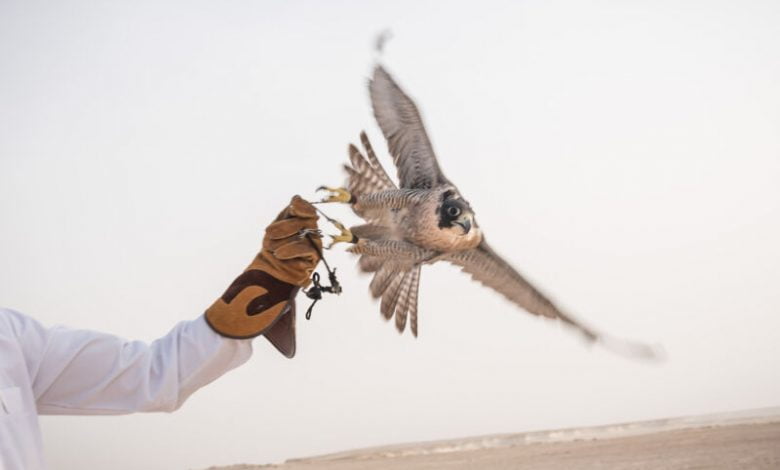Unveiling the Qatar National Bird’s Majesty

Falcons, majestic members of the hawk family, are formidable birds of prey distinguished by their distinctive hook-beaked profiles and exceptional eyesight. These raptors, equipped with powerful talons, command the skies with grace and precision. Renowned as the national bird of Qatar, falcons hold a place of honor in the country’s cultural tapestry. Admired for their strength and beauty, these creatures symbolize the spirit of Qatar, embodying the nation’s deep connection to its natural heritage. Inextricably woven into the fabric of tradition, falconry, the art of hunting with falcons, is not merely a sport but a revered practice that reflects the symbiotic relationship between humans and these magnificent birds. The falcon’s regal presence extends beyond the skies, resonating in Qatar’s identity, where it stands as a proud and iconic emblem of the nation’s enduring legacy.
Origin of Falcons – Qatar’s National Bird
They are ferocious diurnal birds that hunt effectively in the light of day. Falcons stealthily swoop down on their prey as soon as they detect it because they have vision that is nearly 8 times as good as the sharpest human vision. The characteristics of this wild bird gave rise to the custom of hunting fresh meat to improve the diet of desert nomads more than 5000 years ago in Iran, and it expanded across the Middle Eastern nations over time. The art of this heritage was brought to Qatar by the Bedouins. In this region of the world, falcons are a common raptor and are seen as symbols of wealth and aristocracy since keeping a healthy falcon requires a lot of money and effort. These fearsome predators arrive in the nation in the spring and often live 12 to 15 years.
Species of Falcons:
There are six different species of falcons, each with unique traits:
- The Amur Falcon is renowned for its interesting migrations, which span over 22,000 kilometres of the equator.
- Lanner Falcon is distinguished by their striped feathers and a little tooth-shaped notch on its beaks.
- The Saker Falcon, which is the second-largest falcon and is renowned for its beauty and power, is a magnificent bird.
- The Peregrine Falcon, whose maximum flying speed is 389 kilometres per hour, is the fastest animal ever seen.
- Barbary Falcon, a little smaller in size, is most renowned for its beaks, which are razor-sharp and resemble fishing hooks.
- Sooty Falcon, which is long-winged and lean, are well-known for their extensive travels.
The two most popular hunters on the list, Saker and Peregrine, are routinely captured, tamed, and ready for the traditional hunt.
Art of Falconry:
Falconry is a traditional skill that dates back to the Bedouin tribes’ use of the raptor to hunt migratory birds for food. Every time a bird and its trainer form a relationship, it makes for an excellent hunting alliance. This lone bird teaches its falconers, among other things, perseverance, bravery, and patience.
Falcons at Souq Waqif:
Visit the Falcon Souq in Souq Waqif while on vacation in Doha to get a feel for how real this custom is and to learn more about Qatari falconry culture. It is the ideal location for enjoying falcon spotting, up-close photography, and even falcon holding under expert supervision. The government-run Falcon hospital, which treats and heals injured falcons, is located nearby. As part of the taming process, it’s common to see falcons who have been temporarily blindfolded or hooded to keep them calm until they become accustomed to their surroundings or the falconer. The falconry and hunting season starts in October, and tourists can take advantage of this opportunity to watch and learn more about traditional falconry and the deeply ingrained national passion for falcons.
Katara International Hunting and Falcons Festival
Moreover, the Al Gannas-organized Katara International Hunting and Falcons Festival stands as a prominent event dedicated to falcons and hunting in the region. Gaining recognition across the Gulf, the festival is hosted at the Katara Cultural Village Foundation, featuring an iconic structure resembling a falcon’s hood. Serving as Doha’s seventh most recognized landmark, the Al Gannas Association’s central office is within this distinctive structure. The organization’s purpose-built headquarters showcase a unique exhibit of stuffed raptors, highlighting significant species found in Qatar’s wild. Furthermore, the facility provides falconry training and houses a lecture hall.
For a deeper dive into captivating subjects within Qatar, don’t miss the opportunity to explore our website. Immerse yourself in a wealth of information that unveils the rich tapestry of the Qatari lifestyle. Every visit promises to unveil something new, allowing you to continuously expand your understanding and appreciation for Qatar’s cultural nuances and distinctive aspects of life. Visit Hyak Qatar today and make each day an opportunity to enrich your knowledge of Qatari life.






